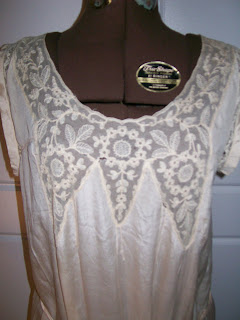Early 1920's Nightgown
This is an extant example of an early 1920's night gown I have in my personal collection. The lace is lovely. The silk is beginning to shatter and is very fragile as it was not stored properly prior to coming to live with me. I have been studying the seams and how it was put together to aid in the assembly of my 1920's envelope chemise. I have concluded this was a ready-made garment purchased from a department store of some sort.
The hem of the gown is two layers of net with 3" lace whip stitched to the bottom. It appears the net was first applied to the silk with a straight stitch in a pointed patern.
The silk was then trimmed close to the seam on the inside of the gown and then hemstitched with a special sewing machine designed for this function only, readily used in factories in the 1920's and 1930's,( Hemstitching Machines built by Singer, Tajima, Golden Wheel, and Cornely) following along the pointed pattern hem and the net was trimmed close to the seam on the outside of the gown. This stitch can be reproduced on modern machines with a hemstitch function by drawing threads and using a wing needle. I plan on playing around with this process later.
The side seams are finished with a tiny felled seam. I imagine that it was dificult to keep that seam even and flat and marvel a the fact that they didn't just use a French seam. I would.







